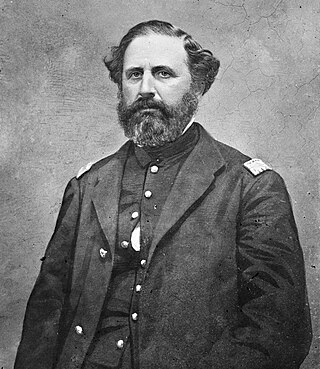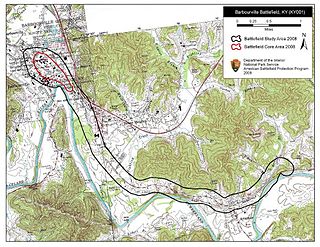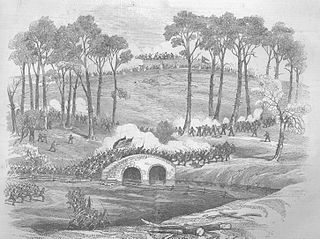
The First Battle of Bull Run, called the Battle of First Manassas by Confederate forces, was the first major battle of the American Civil War. The battle was fought on July 21, 1861, in Prince William County, Virginia, just north of the city of Manassas and about thirty miles west-southwest of Washington, D.C. The Union Army was slow in positioning themselves, allowing Confederate reinforcements time to arrive by rail. Each side had about 18,000 poorly trained and poorly led troops. The battle was a Confederate victory and was followed by a disorganized post-battle retreat of the Union forces.

The Battle of Perryville, also known as the Battle of Chaplin Hills, was fought on October 8, 1862, in the Chaplin Hills west of Perryville, Kentucky, as the culmination of the Confederate Heartland Offensive during the American Civil War. Confederate Gen. Braxton Bragg's Army of Mississippi initially won a tactical victory against primarily a single corps of Maj. Gen. Don Carlos Buell's Union Army of the Ohio. The battle is considered a strategic Union victory, sometimes called the Battle for Kentucky, since Bragg withdrew to Tennessee soon thereafter. The Union retained control of the critical border state of Kentucky for the remainder of the war.

The Battle of Philippi formed part of the Western Virginia Campaign of the American Civil War and was fought in and around Philippi, Virginia, on June 3, 1861. A Union Army victory, it was the first organized land action of the war, though generally viewed as a skirmish rather than a battle.

The First Battle of Kernstown was fought on March 23, 1862, in Frederick County and Winchester, Virginia, the opening battle of Confederate Maj. Gen. Thomas J. "Stonewall" Jackson's campaign through the Shenandoah Valley during the American Civil War.

The Battle of Mill Springs, also known as the Battle of Fishing Creek in Confederate terminology, and the Battle of Logan's Cross Roads in Union terminology, was fought in Wayne and Pulaski counties, near current Nancy, Kentucky, on January 19, 1862, as part of the American Civil War. The Union victory concluded an early Confederate offensive campaign in south central Kentucky.

Charles Champion Gilbert was a United States Army officer during the Mexican–American War and the American Civil War.

The siege of Corinth was an American Civil War engagement lasting from April 29 to May 30, 1862, in Corinth, Mississippi. A collection of Union forces under the overall command of Major General Henry Halleck engaged in a month-long siege of the city, whose Confederate occupants were commanded by General P.G.T. Beauregard. The siege resulted in the capture of the town by Federal forces.

Speed Smith Fry was a lawyer, judge, and a United States Army officer during the Mexican–American War and American Civil War.

The Battle of Barbourville was one of the early engagements of the American Civil War. It took place on September 19, 1861, in Knox County, Kentucky during the campaign known as the Kentucky Confederate Offensive. The battle is considered the first Confederate victory in the commonwealth, and threw a scare into Federal commanders, who rushed troops to central Kentucky to try to repel the invasion, which was finally stopped at the Battle of Camp Wildcat in October.

Kentucky was a southern border state of key importance in the American Civil War. It officially declared its neutrality at the beginning of the war, but after a failed attempt by Confederate General Leonidas Polk to take the state of Kentucky for the Confederacy, the legislature petitioned the Union Army for assistance. Though the Confederacy controlled more than half of Kentucky early in the war, after early 1862 Kentucky came largely under Union control. In the historiography of the Civil War, Kentucky is treated primarily as a southern border state, with special attention to the social divisions during the secession crisis, invasions and raids, internal violence, sporadic guerrilla warfare, federal-state relations, the ending of slavery, and the return of Confederate veterans.

The Battle of Rowlett's Station was a land battle in the American Civil War, fought at the railroad whistle-stop of Rowlett's in Hart County, Kentucky, on December 17, 1861. The outcome was inconclusive, although the Union Army continued to hold its objective, a railroad bridge across the Green River.

The 41st Ohio Infantry Regiment was an infantry regiment in the Union Army during the American Civil War.

The 75th Ohio Infantry Regiment, sometimes 75th Ohio Volunteer Infantry was an infantry regiment from southwestern Ohio in the Union Army during the American Civil War. It served in the Eastern Theater, most notably in the battles of Chancellorsville and Gettysburg and then in the siege operations against Charleston, South Carolina.

The Second Battle of Cynthiana included three separate engagements during the American Civil War that were fought on June 11 and 12, 1864, in Harrison County, Kentucky, in and near the town of Cynthiana. This was part of Confederate Brigadier General John H. Morgan's 1864 Raid into Kentucky. The battle ultimately resulted in a victory by Union forces over the raiders and ended Morgan's Last Kentucky Raid in defeat. Morgan's command had previously captured the town in the First Battle of Cynthiana, July 17, 1862.

In mid-May 1861, U. S. Navy lieutenant William "Bull" Nelson armed Kentuckians loyal to the Union and that soon became the foundation for his receiving authority to enlist 10,000 troops for a campaign into East Tennessee. On August 6, 1861, those recruits marched into Camp Dick Robinson, making it the first Federal base south of the Ohio River. For Col. George C. Kniffen, "the wisdom of President Lincoln commissioning. .. Nelson to organize a military force on the [neutral] soil of Kentucky" prevented making the state a "battle ground for many months" and it thereby changed the whole direction of the war. In 1864, Salmon P. Chase declared in a speech at Louisville "when Kentucky faltered, hesitated" in the early stages of the Civil War, that undecided "status was settled by WILLIAM NELSON, at Camp Dick Robinson." Six years later, Indiana Senator Daniel D. Pratt reported to the U. S. Senate that Camp Dick Robinson "was one of the most noted military encampments of the war.. .. From its admirable locality and advantages, it was almost indispensable for the successful operations of the" Civil War.

The 21st Massachusetts Infantry Regiment was an infantry regiment in the Union Army during the American Civil War. It was organized in Worcester, Massachusetts and mustered into service on August 23, 1861.

The 64th Virginia Mounted Infantry Regiment was formed from troops raised in Lee, Scott, Wise and Buchanan counties in Virginia for service in the Confederate States Army during the American Civil War. It served as an infantry regiment, a cavalry regiment, and a mounted infantry (dragoon) unit, and had a mixed reputation.

The 5th Kentucky Infantry Regiment was an infantry regiment that served in the Confederate States Army during the American Civil War. In 1863 it became part of the First Kentucky Brigade.
The Battle of Camp Wildcat was one of the early engagements of the American Civil War. It occurred October 21, 1861, in northern Laurel County, Kentucky during the campaign known as the Kentucky Confederate Offensive or Operations in Eastern Kentucky (1861). The battle is considered one of the first Union victories of the Civil War, and marked the second engagement of troops in the Commonwealth of Kentucky.



















